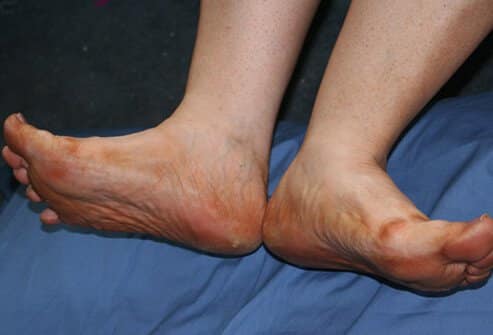Diabetes is a condition in which the amount of glucose (sugar) in the blood is too high because the body is unable to use it properly. This is because insulin is lacking, or the body’s way of converting glucose into energy is not working properly.
There are two common types of diabetes:
Type 1: is an auto-immune disease where the body’s immune system attacks the insulin-producing cells in the pancreas. As a result people with type 1 diabetes can not produce insulin and rely on insulin injections to survive.
Type 2: is the most common type of diabetes, and is usually a result of hereditary factors and lifestyle risk factors including poor diet, insufficient physical activity and being over weight or obese.
How diabetes can affect your feet

Your feet are supplied with blood to keep them healthy. They also have lots of nerves that act as a communication and warning system. For example if you have a stone in your shoe, the nerves in your foot will send a message to your brain letting you know they are in pain or discomfort. However if your diabetes is poorly controlled for a long period of time this can lead to nerve damage.
Nerve damage may mean that you no longer notice a stone in your shoe, due to loss of feeling in your feet. This can result in an injury or wound you cant feel and possibly an infection.
If you have poor circulation, any injuries, wounds or infections to your feet such as cuts, burns or blisters will take longer to heal. This is due to less blood flowing to your feet to assist in healing any damaged tissue.
When you have nerve damage and or poor circulation, you will need to take extra care to protect your feet from injury and wounds. Many foot problems in people who have diabetes occur when injuries and wounds, as well as infections go unnoticed and untreated, or when healing is delayed due to poor circulation. This can result in serious ulcers and in sever cases amputation of parts of the foot.
How can you detect changes early?
A yearly check up by your podiatrist will help to detect any changes early, before they become a serious problem. Your podiatrist will examine your circulation by measuring foot pulses. They will also examine your nerve sensation by testing pressure sensitivity, vibration and or reflexes and other tests may be considered necessary.
To prevent problems you should do the following;
•Protect your feet from injury by wearing suitable foot wear
•Inspect your feet every day – your podiatrist can show you how
•see your podiatrist immediately is something is not healing or you find any red swollen areas on your feet
Additional advice
•Where possible wear lace up shoes which are deep and broad enough, especially at the toes for your foot.
•Check the inside of your shoes for rough edges, shake them out before use to make sure there is nothing loose inside.
•Cotton hosiery, socks and tights, worn with leather upper shoes are good choices.
As a general health guide
•Maintain recommended blood and sugar levels
•Don’t smoke
•Exercise regularly
•Avoid walking barefoot
•Keep your feet clean
•Wear well fitting shoes
•Cut and file your toenails carefully and regularly
•Have corns, calluses and other foot problems treated by a podiatrist
•Seek your podiatrist’s advice if you have and foot concerns sooner rather then later
Remember
With nerve damage or altered sensation you may experience numbness in your feet. Cuts, blisters, ingrown toenails and corns may often go unnoticed. Reduced blood supply and poor circulation can slow down the healing process. PROTECT your feet from injury. INSPECT your feet everyday. Have your feet ASSESSED every year by your podiatrist.
If you are concerned about your feet and lower leg health, contact us at Canberra Podiatry, please call 6281 1200.





